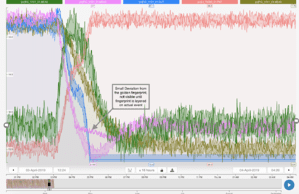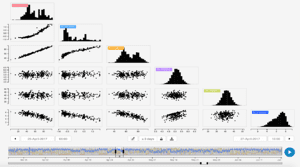Time-series Use Cases for Industrial IoT
Time-series data analytics allows insights into nearly anything that occurs over time. But how do you decide where to apply it in industry?

In the manufacturing industry, most of the process systems – like IoT sensors, industrial machines, control devices – generate time series data. Time-series data tends to be robust (i.e. rapidly filling up multi-gigabyte storage in a few days), so performance and scalability are crucial. One of the key requirements for working with time-series data is the ability to analyze and aggregate the data very, very quickly.
Using analytics, you can explore and search data easily and improve product quality, avoid accidents and reduce environmental impact. These tools help you to avoid damage and reduce the downtime of high maintenance machinery in the process industry. Equally important, they provide actionable insights that empower your engineers to save time while making smarter, more data-driven decisions.
Here are three different examples of actual industrial use cases I have seen, where time-series data has provided rich insights into process optimization and the health of production equipment.
1. Root cause analysis of vacuum system/pumps failure
This involved quite a few customers with vacuum systems or, in some cases, the specific vacuum pumps. When the desired operating condition isn’t provided at a process plant (in this case vacuum), production often stops, and engineers tend to think that vacuum pumps are causing the problem. However, in most of the cases either 1) the pump is being operated in a condition for which it was never intended, 2) one or more of the process variables points with the pump (suction/discharge lines, water supply, process contaminants, etc.) are being operated outside of design parameters, or 3) the vacuum chamber or vacuum lines were improperly specified/designed.

Using Software AG’s TrendMiner analytics software, you can systematically identify the root cause of the most common problems and correct them based on general vacuum system recommendations as well as visual/statistical data analytics techniques.
2. Predictive maintenance of catalyst deactivation
A well-performing catalyst is an important part of the various industrial production processes such as chemical, petrochemical and pharmaceutical. Early deactivation/ poisoning of catalyst is a problem and it’s very expensive to shut down the process and replace it. The eventual catalyst deactivation is unavoidable, however in some cases rapid decay may be avoided or postponed.
In one of the cases, catalyst deactivation was easily calculated and aggregated with our “Tag Builder” functionality when a few cycles of catalyst deactivation were visualized clearly. TrendMiner’s Predictive Mode predicted the most probable cause of catalyst deactivation for predictive maintenance of the catalyst. Afterward, a dashboard was set up to continuously monitor the activity of the catalyst which enabled higher visibility and allowed earlier interventions.
3. Abrupt Shutdowns of Dryer/Agitators
The main challenge with rotating equipment like dryers and agitators is that, over time, they can behave erratically, often with abrupt shut-downs. This can go unnoticed for hours with the product be sitting in agitators for hours or days, leading to bad quality products and financial losses. This is not uncommon; the problem could be mechanical such as shaft misalignment or could be purely process-related.

In most of the observed cases at least a few years of data was available. The problem was defined using different tags (sensor readings) like agitator speed, moisture content, valve positions, etc. To find the root cause of the problem, it was necessary to find similar events. When data from thousands of sensors are present, searching for a few specific events quickly is crucial. Various available searches in TrendMiner can search for patterns or events. These events were layered on top of each other for visual comparison.
In finding out the root cause, correlation analysis is very useful. The recommendation engine can be used to perform correlation analysis, to identify the cause of problematic process situations. Based on the tags and layers visualized, the recommendation engine will suggest tags of interest to be added to the view. In these cases, it found the process and captured mechanical issues. In one case it finds that the valve position of raw material was causing the problem.
TrendMiner has a number of applications in the pipeline for the process and oil and gas industries. Read more by clicking below.